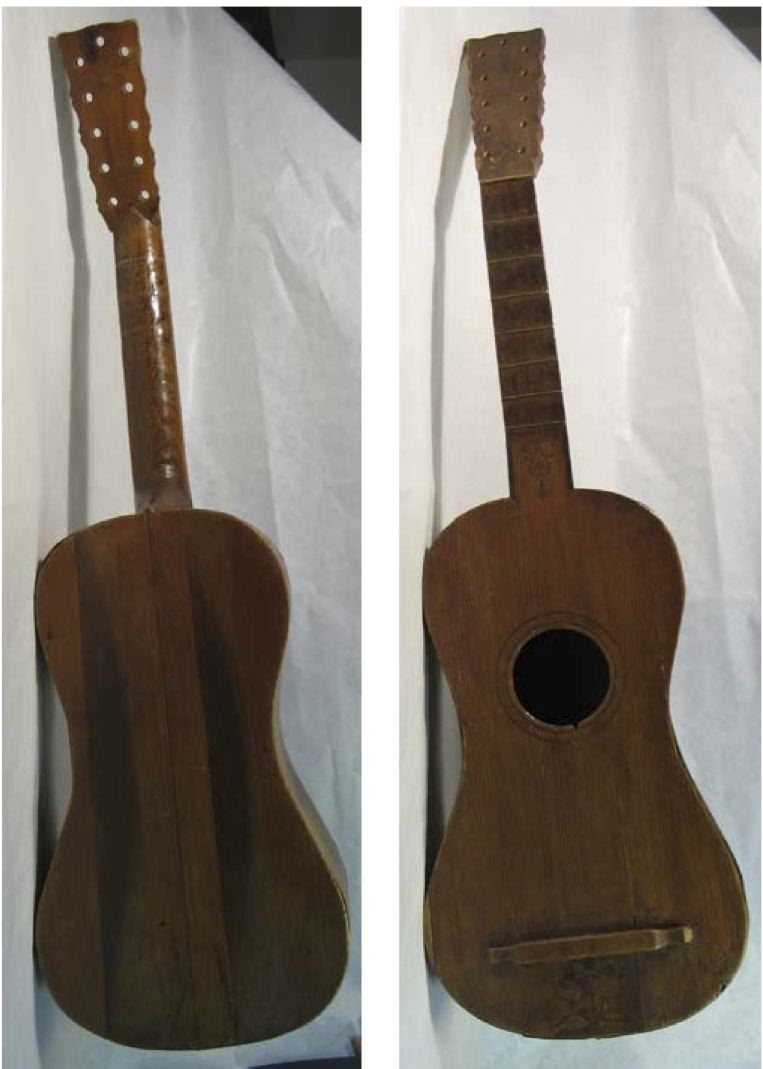Vihuela or guitar
(1600/ca) - Avila, Convento de la Encarnación.
instrument: vihuela de mano | century: 16cent/3/late 17cent/1/early | catalogue nº: 16-315

Artwork
Creator
Medium Instrument
Location
City Avila | Region Castilla-León | Old kingdom Castile
Characteristics
| Body Waisted | Strings 5 courses | Neck Medium | Pegbox |
| Bridge Fixed | Frets | Back Flat | Pegs Rear |
| Technique None |
Commentary
INSTRUMENT
Whether this instrument should be called a vihuela or a guitar is disputed. One of the oldest surviving Spanish instruments, possibly from the late 16th or early 17th centuries. Originally it could have been either a five-course or six-course instrument, either a vihuela or a guitar. The bridge is not original, and the pegbox has 11 peg holes, 5 on each side, plus one in the centre of the pegbox, possibly for an eleventh string. The soundboard has two bars, above and below the soundboard, and none on the back. First described by Romanillos [see romanillos1990, p. 50]. Subsequently described and evaluated in detail by Bosser [bosser2009]. The instrument is housed in a display cabinent with other instruments of the same period including 2 harps, a viola da gamba, bajón, drums, and music manuscripts.
• Romanillos [romanillos2003, p. xxiii] mentions the instrument, the “earliest authenticated five-course Spanish guitar in the Convento de la Encarnación, Ávila, Spain, made in the closing years of the sixteenth century or the beginning of the seventeenth, (Alfonso de Vicente 1989)… The Ávila guitar has a waisted body with a flat back and the soundboard supported by two harmonic bars, one above and the other below the soundhole, with scalloped ends which rest on the tuning fork props glued transversely on the inside of the sides. The back has no transverse bars and no evidence of having had linings or glue-blocks. The neck is in the Spanish style with a long slipper section and there is evidence that it had a rose glued on the underside of the soundhole.”
• Joan Pellisa reports (vihue-lista 20 July 2006): The irigiunal bridge is not preserved and, even if ten pegs can be oberved on the pegbox, there is also a tapered hole suppoesedly for a string to hang it with, but that could equally be for another tuning peg. In some baroque guitars of the late 17th and early 18th centuries of the Catalan school, bridges and nuts can be observed that can indiscriminately take five or six courses of strings, for which reason it does not seem out of the question to think that the same instrument could be used either as a “guitar” or a “vihuela” simply by changing the [number of] strings. In the Catalan instruments to which I refer, it would be possible to string them with five double courses and another way with a single first and sixth course and double courses in between (as still found in some guitars in Mallorca, Cataluña and Aragón. Similarly, the guitarra “de los leones” is very similar to the Avila guitar in organological features such as the proportions between the lengths of the soundbox, neck, and string length, as well as the way the thicknesses of the soundboard are made, and the outline is suspiciously similar. Even though all of this are just annotations which will only be brought to conclusion once the masters who exhaustively studied the instrument in Avila publish the data the y have collected.
• On the instruments in the monastery, see: http://delaruecaalapluma.wordpress.com/2014/02/17/instrumentos-musicales-en-el-convento-de-la-encarnacion/ [accessed 4/08/2014] although better photos are in the the Hispanica Lyra article.
Reproductions
https://delaruecaalapluma.files.wordpress.com/2014/02/gredos2011encarnacion-s-santa-024-copia11.jpg